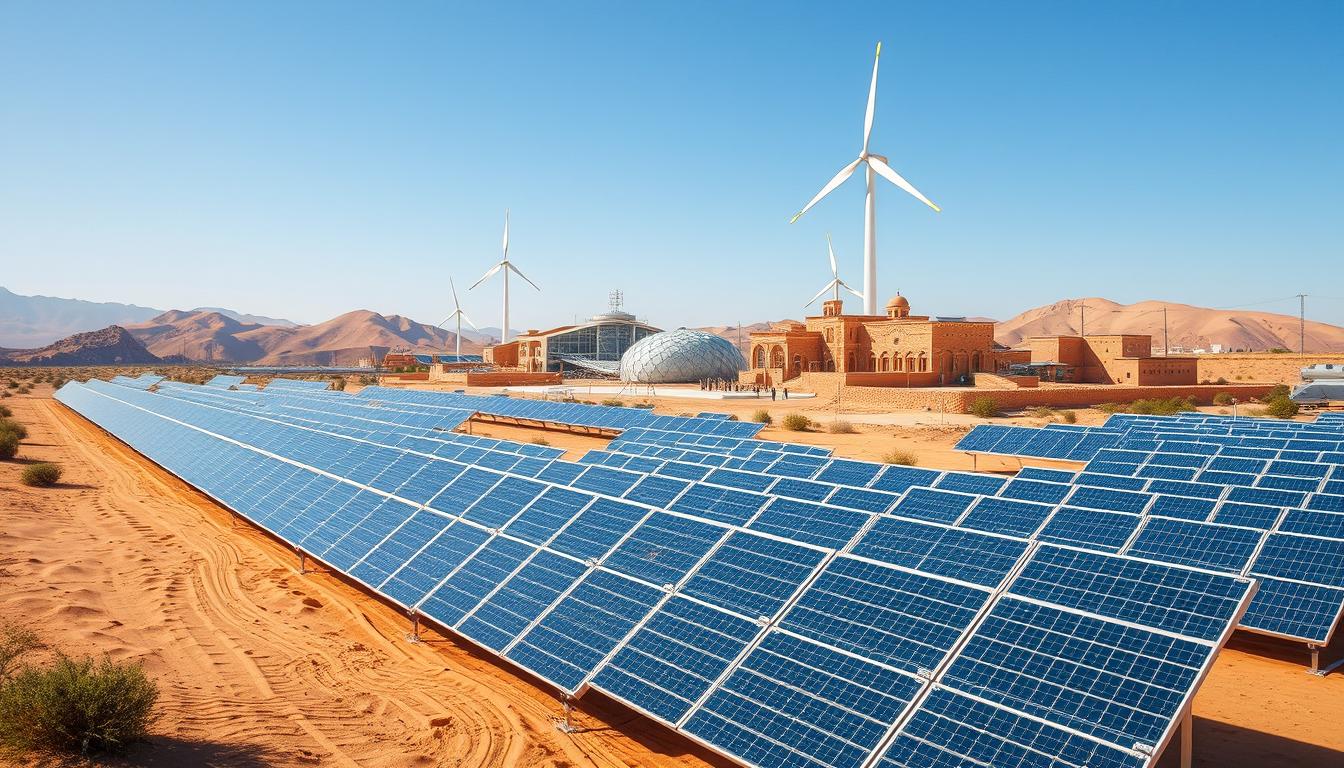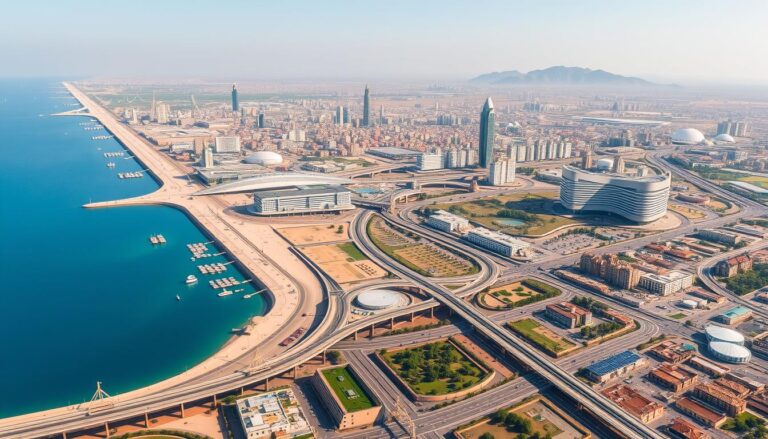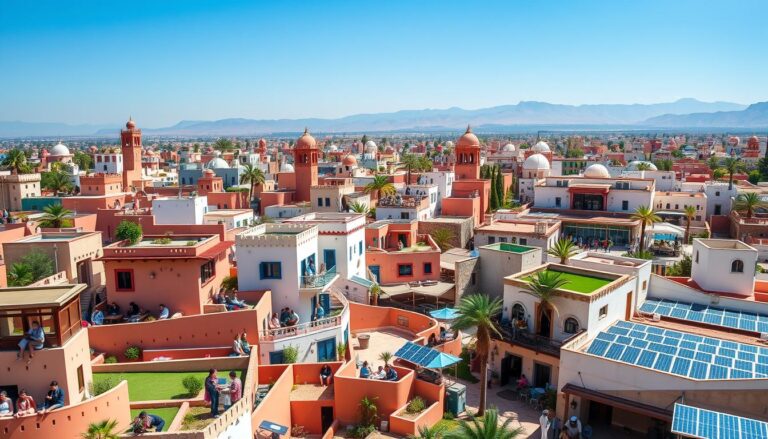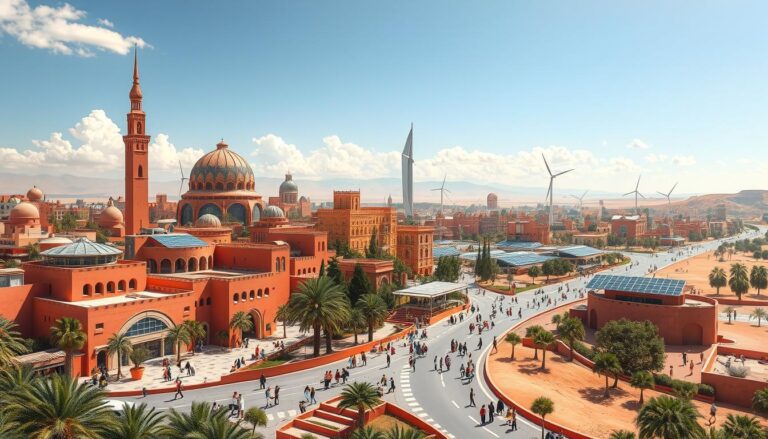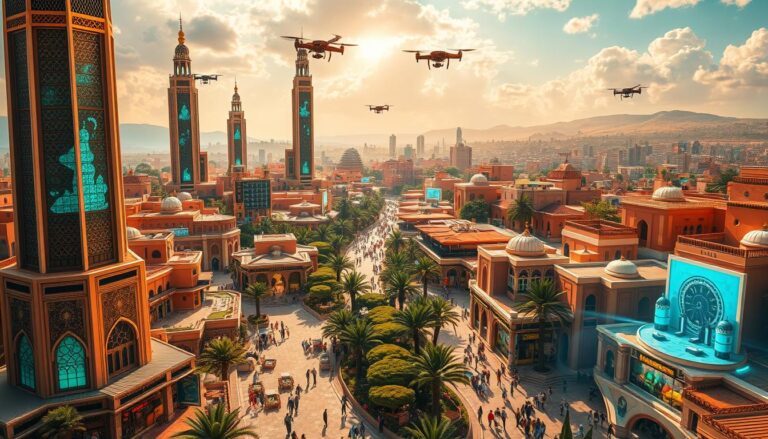Is Morocco set to lead the world in green hydrogen? The country has a clear plan and big goals for its energy sector. The Moroccan Ministry of Energy, Mines and Environment has a bold vision. They aim for 30 TWh of hydrogen energy by 2030 and 307 TWh by 2050.
Morocco’s plan is not just for local use. They want to grab up to 4% of the global green hydrogen market by 2030. This will need a lot of new renewable energy and could create over 15,000 jobs. The journey to success will have its ups and downs.
Morocco’s Vision for Green Hydrogen
Morocco is working to become a top player in green hydrogen production. It aims to supply over 4% of the world’s green hydrogen by 2030. The country is using its vast renewable energy and strategic location to achieve this goal.
The vision for Morocco’s green energy is linked to its economic and industrial growth. This is a key part of the country’s development plan.
Economic and Industrial Sector
Morocco plans to use over 1 million hectares for green hydrogen projects. The first phase will cover around 300,000 hectares. These projects will create new industries and jobs.
A good investment environment, with tax and customs benefits, is being set up. This is to attract investors and speed up the use of clean energy in Morocco.
Energy Transition and Reduction of Greenhouse Gases
Morocco is working hard to cut down greenhouse gas emissions. The country aims to add 6 GW of new renewable energy by 2030. This will include solar, wind, and hydropower.
This clean energy will help both at home and abroad. It will also create over 15,000 jobs in Morocco. This shows the country’s commitment to sustainable growth.
Export Opportunities
Morocco is well-placed to export green hydrogen thanks to its location and infrastructure. The country hopes to meet an export demand of 10 TWh by 2030. It plans to sell to Europe through free trade agreements.
By 2050, Morocco’s green hydrogen industry could grow even more. It could meet demands ranging from 153.9 TWh to 307.1 TWh. This opens up big opportunities for exports.
National Strategy for Hydrogen Energy
The Moroccan government has a big plan for hydrogen energy. It’s through the National Hydrogen Commission. The plan has three main parts: growing the market, improving technology, and bringing in more investment.
Three Pillars: Market, Technology, and Investment
Morocco wants to grow its hydrogen market, improve technology, and attract more investors. They’ve set aside 300,000 hectares for green hydrogen projects. These projects are being reviewed by MASEN.
Choosing investors is tough. They must show they care about local development and can make money for Morocco. The goal is to make Morocco a top player in green hydrogen.
Phases of Development: 2020-2050
The plan spans from 2020 to 2050, with three main stages. The first stage is about building the needed infrastructure. The second stage is about making things cheaper and using hydrogen in more ways.
The third stage is about using hydrogen in many different ways. By 2030, Morocco hopes to cut down on coal use a lot. This is part of their goal to use 80% renewable energy by 2050.
Ammonia Production and Energy Security
Ammonia production is key in Morocco’s hydrogen plan. It helps reduce imports and makes energy more secure. TotalEnergies, a French company, is investing $10 billion in a project in Guelmim-Oued Noun.
This project is a big step towards using more sustainable energy. It also makes Morocco stronger in the global green hydrogen market.
Renewable Energy Potential in Morocco
Morocco is leading the way in renewable energy. It wants to cut down on using imported fossil fuels. These fuels currently make up 90 percent of the country’s energy use.
In 2022, renewable energy made up 38 percent of Morocco’s power mix. This totalled 4,154 MW. The goal is to boost this to over 52 percent by 2030.
Solar and Wind Energy Projects
Morocco’s projects in solar and wind energy are key to its green hydrogen plans. The Noor Ouarzazate Solar Complex is a big player. It has an average solar potential of 5 kWh per square meter per day.
This makes Morocco a top player in solar energy, with 831 MW installed. The country also has a strong wind energy potential. It can generate 25,000 MW, with 1,553 MW already in use.
The National Office of Electricity and Water (ONEE) aims for 10 GW from renewable energy by 2030. This shows Morocco’s strong commitment to clean energy. The current solar and wind projects are a solid base for its green hydrogen goals.
Guelmim-Oued Noun Green Project
The Guelmim-Oued Noun green project is a big step for Morocco. It’s backed by Total Energies and will boost the country’s renewable energy sector. It will also help Morocco meet its goals for renewable energy and green hydrogen.
The Role of International Partnerships
International partnerships are key to Morocco’s hydrogen energy goals. The German Moroccan Energy Partnership (PAREMA) is a big help. It boosts hydrogen fuel cells and renewable energy investments. The Germany-Morocco Hydrogen Agreement also shows strong commitment.
German Moroccan Energy Partnership
The German Moroccan Energy Partnership (PAREMA) is crucial for Morocco’s hydrogen sector. It aims to increase energy transition and cut greenhouse gas emissions. PAREMA supports renewable energy projects with strategic plans and funding.
Total Energies Project
Total Energies is also playing a big role. It’s working to use Morocco’s renewable energy for green hydrogen. This includes solar and wind energy projects. These efforts help create a strong green hydrogen market.
Investment and Financial Support
Organizations like KfW give important financial help for renewable energy. This helps Morocco in the global green hydrogen market. Investments are key for infrastructure, research, and technology. Working with IRENA and the European Commission is also vital for a strong green hydrogen economy.
Technological Innovations in Hydrogen Production
Morocco is working hard to make hydrogen production better and greener. It’s focusing on making the process more efficient and sustainable. The key to this is new technology, especially in electrolysis.
Advancements in Electrolysis
Electrolysis, which splits water into hydrogen and oxygen using electricity, is getting better in Morocco. This improvement will make green hydrogen cheaper and more efficient. The country is also looking into using marine energy, like wind and waves, to power electrolysis.
Morocco’s long coastline is perfect for catching wave energy. This energy can help make hydrogen production more sustainable.
Research and Development Efforts
Research and development are key to keeping innovation alive in green hydrogen. Groups like the Green Hydrogen Industry Forum and international conferences are important. They help share knowledge and work together.
Events like the “Green Hydrogen Camp Morocco” are training the next generation of engineers. They focus on hydrogen technology. This is crucial for the future of green hydrogen.
Leaders like Leila Benali, Minister of Energy Transition, are pushing for progress. They’re working with Royal Air Maroc and the Moroccan Sustainable Energy Agency. Morocco aims to get 52% of its electricity from renewables by 2030. This goal supports the development of green hydrogen technologies.
Building the Hydrogen Infrastructure
In Morocco’s quest for green energy, setting up a strong hydrogen infrastructure is key. This means building advanced storage and distribution systems. It also includes making big changes in port and transport systems for handling hydrogen efficiently.
Port and Transport Infrastructure
Morocco’s location makes it important to upgrade its ports for hydrogen trade. The country needs a hydrogen pipeline network, which will cost $76 billion by 2050. This money will help in building renewable energy, electrolysers, and conversion plants.
The Maghreb Europe Gas Pipeline could help send hydrogen to Europe. This shows the need for special port and marine logistics that meet global standards.
Storage and Distribution Networks
Having good storage and distribution systems is vital for Morocco’s green energy shift. The country faces barriers like lacking infrastructure for hydrogen production, storage, and transport. Improving storage tech, like salt caverns and advanced tanks, is key.
This ensures green energy stays effective over long distances and in different climates. Creating a clear set of rules for hydrogen activities is also important.
Morocco’s farming sector, which uses a lot of water, is another challenge due to water scarcity. Finding new ways to store and produce hydrogen is crucial to tackle these environmental issues.
Hydrogen Energy in Morocco
Morocco is leading the way in clean energy, aiming to be a top player in hydrogen energy. It plans to meet a huge demand for green hydrogen, aiming for 307 TWh by 2050. By 2030, it wants to reach 30 TWh, needing 2GW of renewable energy.
Big investments are making this dream a reality. Morocco aims to have a local hydrogen market of 4 TWh by 2030. It also wants to export 10 TWh, making it a key player globally. This growth will create over 15,000 jobs and add 6GW of new renewable energy.
Big names like Total Energies are backing Morocco’s efforts. They plan to invest €9.4 billion in green hydrogen and ammonia. Germany is also supporting Morocco with €300 million for green hydrogen projects.
Morocco could grab up to 4% of the global hydrogen market by 2030. The demand is expected to grow from 13.9 TWh to 30.1 TWh by 2030. By 2050, it could reach 307.1 TWh.
The country has a national strategy for green hydrogen, launched on March 11, 2024. It aims to cover the whole green hydrogen sector. Over one million hectares have been set aside for these projects, with 300,000 hectares for the first phase.
There are financial incentives for projects over MAD2,000,000,000. Morocco plans to invest between €13 billion and €95 billion by 2050. Its goal is to lead in renewable energy and sustainability.
“Morocco’s dynamic moves towards green hydrogen are setting a benchmark in sustainable development,” highlighted a leading energy analyst.
Morocco’s green hydrogen vision is attracting worldwide attention and investment. It’s on its way to a sustainable and prosperous future.
Challenges and Opportunities
Morocco is working hard to become a top exporter of green hydrogen. It has set aside over 1 million hectares for this goal. The plan is to start with 300,000 hectares first. This could bring big economic and environmental wins.
The “Morocco Offer” aims to help the world reach a zero-carbon future. It’s a big step towards a cleaner planet.
But, there are big hurdles to cross. The cost of making green hydrogen is high. Building the needed infrastructure and solving tech problems are also big challenges. Yet, Morocco is tackling these issues head-on.
The country is working together with the government, private sector, and global partners. This teamwork is key to making green hydrogen projects work.
“Close collaboration between governmental bodies and private enterprises, supported by international stakeholders, will be pivotal in overcoming these challenges and seizing the opportunities in hydrogen energy,” states a recent report from Deloitte.
Morocco could make a big splash in the global energy market. Europe, in particular, is looking for clean energy sources. Morocco’s strong focus on renewable energy, like solar and wind, is crucial for this effort.
Improvements in technology and research will help lower costs and make green hydrogen more efficient. This will help Morocco stand out in the world market.
In 2020, Morocco used 33.52 TWh of electricity, growing by 5%-7% each year. By 2030, it’s expected to use over 160 PJ of electricity. The need for clean energy is urgent, especially since Morocco imports most of its energy.
In 2022, Morocco’s power generation capacity reached 15 GW. Renewables were ahead of oil and gas in this area. This shows Morocco’s commitment to clean energy.
While making green hydrogen is costly and complex, the benefits are worth it. With help from groups like IRENA and the IEA, and advice from countries like Germany, Morocco is ready to face these challenges. The future of green hydrogen in Morocco looks bright, thanks to strong investments and a focus on sustainability.
Conclusion
Morocco is leading the way in clean energy, aiming for a hydrogen future. It’s all about being green and independent. The country is working with others, improving tech, and building new infrastructure. This makes Morocco a key player in the world’s energy shift.
By using solar and wind power, Morocco is moving away from fossil fuels. It’s becoming a clean energy exporter. This move meets the world’s need for green solutions and shows Morocco’s commitment to the environment.
The Moroccan government is making big moves. It’s setting aside land for green hydrogen and upgrading ports and pipelines. These steps show Morocco’s commitment to a green future.
In short, Morocco’s hard work in planning, tech, and partnerships is changing its energy scene. Its path to a green hydrogen future is inspiring others. Morocco shows that clean energy can boost the economy, improve security, and help the planet.
Source Links
- Morocco
- Morocco and the Future of Green Hydrogen
- Morocco: Green hydrogen – the Moroccan Offer
- MASEN – Offre Maroc Hydrogène Vert
- Morocco’s Energy Transition: Prioritizing Natural Gas, Embracing Green Hydrogen, and Global Collaboration at COP28
- Morocco to become leader in green hydrogen production market
- Realizing North Africa’s green hydrogen potential
- Morocco – Energy
- Four Reasons Why Morocco Is Becoming a Renewable Energy Powerhouse
- Morocco reveals strategy to speed up energy transition | AGBI
- Morocco and IRENA Partner to Boost Renewables and Green Hydrogen Development
- Morocco Collaborates with IRENA to Accelerate Hydrogen Transition & Boost Renewable Green Energy – Morocco Travel Blog
- Morocco continues to promote green hydrogen through a number of initiatives
- Marine Renewable-Driven Green Hydrogen Production toward a Sustainable Solution and a Low-Carbon Future in Morocco
- Morocco’s emergence as a green hydrogen leader – African Association of Entrepreneurs
- Green Hydrogen market in Morocco: needs and barriers
- Morocco Green Hydrogen Offer – key takeaways | JD Supra
- Morocco Green Hydrogen Offer – key takeaways
- Morocco’s Strategic Move in the Green Hydrogen Sector: Unveiling the "Morocco Offer"Article
- A Critical Analysis of Morocco’s Green Hydrogen Roadmap: A Modelling Approach to Assess Country Readiness from the Energy Trilemma Perspective
- Just Energy Transitions? Lessons From Oman and Morocco

The Editorial Team is a passionate group of Morocco enthusiasts dedicated to sharing the beauty, culture, and wonders of this captivating country. With diverse backgrounds and a deep love for travel, we strive to bring you engaging and informative content that inspires your Moroccan adventures. From uncovering hidden gems and sharing local insights to exploring mouthwatering cuisine and showcasing the vibrant lifestyle, our team is committed to providing you with valuable resources and exciting stories that enhance your exploration of Morocco. Join us on this journey as we celebrate the rich heritage and unforgettable experiences that make Morocco truly special.

